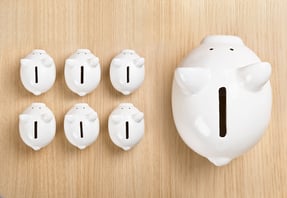Inflation Is Inevitable - What Can we Expect in the Future?

Sticker shock at the grocery store? Price hikes at the pumps? It's no secret that prices are going up and spending more for basics can be startling.
Do you remember the first time you noticed prices increasing? It often happens so gradually that we don’t even notice. However, inflation is often more complicated than we realize and it’ll be with us for the rest of our lives.
So, what could prices look like in 2030? Let's find out by looking at some historical data, and projecting how prices for things like food and housing could go up.
What is Inflation?
Inflation is a measurement of how fast the prices of goods and services increase. As inflation rises, prices do too because it takes more dollars to buy the same things. Deflation is the opposite — it brings lower prices and more buying power.
Both inflation and deflation are tied to a complex web of economic factors — such as supply and demand, wages, government spending, taxes, and more.
The Consumer Price Index (CPI) is a useful indicator of inflation or deflation. It's sort of a cost-of-living index, looking at price changes, over time, for the goods and services used by households.
The prices and predictions that follow are based on historical averages going back to 2000 for different areas of spending.
Housing.
Average annual inflation rate: 2.39%1
Housing could be almost 27% more expensive by 2030.1 That means a house that costs $400,000 today could run you $506,388 in 10 years.
Depending on where you're buying in the future, you could be paying much more than that. In fact, by 2030, the average home in Washington state will probably run you $782,708.2
If you prefer the Aloha state, expect to fork over $889,627 for an average home. And topping the list for the fastest rising housing prices is California, where the average home will likely cost more than $1 million by 2030.2
Food & Beverage
Average annual inflation rate: 2.33%3
Food and drinks may be about 26% more expensive by 2030.3 That means a trip to the grocery store that costs you $250 now could set you back more than $314.3
If you like fresh fruit, your grocery bills could climb higher even sooner. That's because prices for fresh fruit have been rising at about twice the pace of meat, poultry, and fish.4
As food costs across the board continue to rise, they may not be the only thing about your food purchases that change by 2030. Your diet could, too. In fact, by 2030, more folks may give up red meat, replacing it with poultry and dairy products.5
College
Average annual inflation rate: 4.93%11
A public four-year university may be about 62% more expensive by 2030.11 Annual tuition and fees of $4,000 today for a two-year college could cost $6,324 by 2030.11
For a four-year public university that runs you $20,000 today, you're looking at $32,376 within 10 years.5 And a private four-year university cost of $44,000 could increase to $68,022 by 2030.11
However, the higher education industry is being massively disrupted by virtual learning and changing educational preferences. Within 10 years, these and other factors are bound to change, making higher education costs challenging to predict.
Like many things in life and money, inflation isn't always bad.
Inflation affects far more than upfront prices. It shakes up the costs of doing business and borrowing money. And it can affect savings, bonds, and plans for the future.
We often don’t notice these changes year to year, though.
That’s because inflation comes in small doses. A few bucks more here, a couple hundred more there — it creeps up over time.
And it’s the reason why inflation has a well-deserved reputation as a “silent killer.”
Still, like many things in life and finance, inflation isn’t all bad.
When steady and predictable, a moderate amount can be good as it can signal a healthy, growing economy.
Inflation causes problems when it increases suddenly and rapidly. Or when folks haven’t planned for future price increases.
Have questions about how inflation works or what it means for you? We're here to help.
Sources:
1 -https://fred.stlouisfed.org/series/CPIHOSSL (Annual average)
2 -https://magazine.realtor/daily-news/2020/10/27/what-will-homes-be-worth-in-10-years
3 -https://fred.stlouisfed.org/series/CPIFABSL (Annual average)
4 -https://www.ers.usda.gov/data-products/food-price-outlook/summary-findings/
6 -https://fred.stlouisfed.org/series/WPU51 (Annual average)
7 -https://www.fidelity.com/viewpoints/personal-finance/plan-for-rising-health-care-costs
8 -https://fred.stlouisfed.org/series/CPITRNSL (Annual average)
11 -https://research.collegeboard.org/xlsx/trends-college-pricing-excel-data-2020.xlsx (Current Dollars Public Two-Year Tuition and Fees, Public Four-Year Tuition and Fees and Room and Board, Private Nonprofit Four-Year Tuition and Fees and Room and Board)


